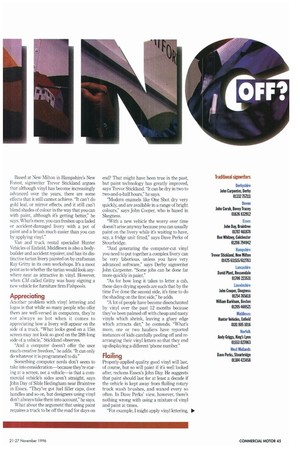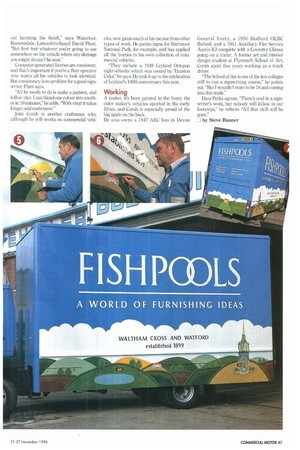Based at New Milton in Hampshire's New Forest, signwriter Trevor
Page 47

Page 48

Page 49

If you've noticed an error in this article please click here to report it so we can fix it.
Stickland argues that although vinyl has become increasingly advanced over the years, there are some effects that it still cannot achieve. "It can't do gold leaf, or mirror effects, and it still can't blend shades of colour in the way that you can with paint, although it's getting better," he says. What's more, you can freshen up a faded or accident-damaged livery with a pot of paint and a brush much easier than you can by applying vinyl."
Van and truck rental specialist Hunter Vehicles of Enfield, Middlesex is also a bodybuilder and accident repairer, and has its distinctive tartan livery painted on by craftsman Ray Gritty in its own workshops. It's a moot point as to whether the tartan would look anywhere near as attractive in vinyl. However, when CM called Gritty was busy signing a new vehicle for furniture firm Fishpools.
Another problem with vinyl lettering and logos is that while so many people who offer them are well-versed in computers, they're not always so hot when it comes to appreciating how a livery will appear on the side of a truck. "What looks good on a 15in screen may not look so good on the 28ft-long side of a vehicle," Stickland observes.
And a computer doesn't offer the user much creative freedom," he adds. "It can only do whatever it is programmed to do."
Something computer nerds don't seem to take into consideration—because they're staring at a screen, not a vehicle—is that a commercial vehicle's sides aren't straight, says John Day of Sible Hedingham near Braintree in Essex. "They've got fuel filler caps, door handles and so on, but designers using vinyl don't always take them into account," he says.
What about the argument that using paint requires a truck to be off the road for days on end? That might have been true in the past, but paint technology has greatly improved, says Trevor Stickland. "It can be dry in two to two-and-a-half hours," he says.
"Modern enamels like One Shot dry very quickly, and are available in a range of bright colours," says John Cooper, who is based in Skegnes. s.
"With a new vehicle the worry over time doesn't arise anyway because you can usually paint on the livery while it's waiting to have, say, a fridge unit fitted," says Dave Perks of Stourbridge.
'And generating the computer-cut vinyl you need to put together a complex livery can be very laborious, unless you have very advanced software," says Derby signwriter John Carpenter. "Some jobs can be done far more quickly in paint."
"As for how long it takes to letter a cab, these days drying speeds are such that by the time I've done the second side, it's time to do the shading on the first side," he adds.
"A lot of people have become disenchanted by vinyl over the past 12 months because they've been palmed off with cheap and nasty vinyls which shrink, leaving a gluey edge which attracts dirt," he contends. "What's more, one or two hauliers have reported instances of kids carefully peeling off and rearranging their vinyl letters so that they end up displaying a different 'phone number."
Properly-applied quality good vinyl will last, of course, but so will paint if it's well looked after, reckons Essex's John Day. He suggests that paint should last for at least a decade if the vehicle is kept away from flailing rotary truck wash brushes, and waxed every so often. In Dave Perks' view, however, there's nothing wrong with using a mixture of vinyl and paint at times.
"For example, I might apply vinyl lettering, 10. but paint the logo on," he says. "That said, if its a 3ft high letter, it can be cheaper to use paint."
Nor is it true that vinyl is always cheaper, Trevor Stickland adds. "A logo that requires six or seven colours could cost you £500 if you have it done in vinyl, but I could probably do it for £370," he says.
However, Stickland admits that the grip vinyl now has on truck operators means few craftsman signwriters can rely solely on hauliers for their income. So he also paints pub signs, and letters boats.
This ability to diversify has ensured he keeps busy, and has encouraged him to pass on his skills to a succession of school leavers. "I take one on each year, and I always ask the school to send me somebody who is reasonable at woodwork or art, but whom they reckon is unteachable," he explains. "I don't want computer buffs because you'll never get them to learn a trade."
Signwriters work on their own a lot, and tend to be individualists; at times bordering on the eccentric. Stickland rides a unicycle as a hobby, juggles with clubs, balls, and even knives, and is an amateur fire eater.
"I do it for relaxation," he says, straightfaced.
Proponents of vinyl argue that it is easier to remove than paint, but time-served signwriters have mixed views as to whether this is truly the case. "Vinyl leaves a sticky film behind. That has to be taken off and it can't be done that quickly," points out John Corah, who lives at Bovey Tracey, 12 miles south of Exeter.
Even when the vinyl has been peeled away, the livery outline often remains because the paint underneath won't have aged at the same rate as the rest of the paint on the vehicle. The only way to deal with this is with a cutting compound, and a lot of elbow grease.
"If the truck has factory-finished cab paintwork, you can often remove painted signwriting with oven cleaner, usually with out harming the finish," says Waterfoot, Rossensdale, Lancashire-based David Plant. "But first test whatever you're going to use somewhere on the vehicle where any damage you might do can't be seen."
Computer-generated liveries are consistent, and that's important if you're a fleet operator who wants all his vehicles to look identical. But consistency is no problem for a good signwriter, Plant says.
"All he needs to do is make a pattern, and follow that. I can blend one colour into another in 10 minutes," he adds. "With vinyl it takes longer, and costs more."
John Corah is another craftsman who, although he still works on commercial vehi
cies, now gains much of his income from other types of work. He paints signs for Dartmoor National Park, for example, and has applied all the liveries to his own collection of commercial vehicles.
"They include a 1949 Leyland Octopus eight-wheeler which was owned by Taunton Cider," he says. He took it up to the celebration of Leyland's 100th anniversary this year.
A tanker, it's been painted in the livery the eider maker's vehicles sported in the early fifties, and Corah is especially proud of the big apple on the back.
He also owns a 1947 AEC bus in Devon General livery, a 1950 Bedford OLBC flatbed, and a 1941 Auxiliary Fire Service Austin K2 complete with a Coventry Climax pump on a trailer. A former art and interior design student at Plymouth School of Art, Corah spent five years working as a truck driver.
"The School of Art is one of the few colleges still to run a signwriting course," he points out. "But I wouldn't want to be 18 and coming into this trade."
Dave Perks agrees, "There's soul in a signwriter's work, but nobody will follow in our footsteps," he reflects. "All that skill will be gone."
by Steve Banner




















































































































































































































